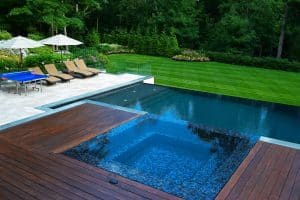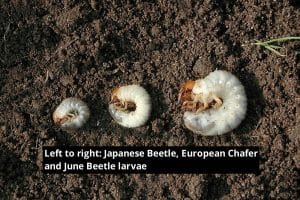 Have skunks, raccoons, and birds suddenly taken an interest in your turf? Does the grass feel spongy when you step on it? Can you actually pull back a section of turf like you’re rolling back a blanket?
Have skunks, raccoons, and birds suddenly taken an interest in your turf? Does the grass feel spongy when you step on it? Can you actually pull back a section of turf like you’re rolling back a blanket?
If you answered yes to any of these questions, there’s a good chance the culprit is burrowed into the soil under your grass, where it can snack on organic matter and grassroots.
Grubs are a damaging yard pest, and these ¾-inch long C-shaped larvae come from different beetles. The most prominent larvae in New York, Connecticut, and New Jersey come from Japanese Beetles and European chafers.
The thing about grubs in turf is, they can do a lot of damage before you realize it. Grass grubs are most destructive in mid-to-late-summer, but in healthy turf, you might not notice a serious impact until early fall. (By then, it’s too late to prevent them and you must move to curative efforts.) The best action is to hire a professional pest control company to prevent grubs before they hatch in summer and feed on your grass.
Turf pests can be a recurring issue because, after a season of feeding on (and destroying) your turf, they burrow deeper into the soil where they can survive during winter. When the soil temperature warms up in spring, that’s their wake-up call to move closer to the soil surface and start the cycle again.
Any landscape with a history of grub damage needs to take action to stop larvae from spreading. If your neighbors have struggled with larvae in lawns, you’ll be dealing with the issue before long. Property lines mean nothing to turf insects or diseases. In our opinion, every turf can benefit from a grub preventive because it can save you the cost of repairing a damaged lawn down the road.
Prevent Grub Larvae in Early Summer
 Spring and early summer is the ideal window for preventing turf pests. If you stop grubs before they hatch, proliferate, feed and cause real damage, you can avoid the frustration of grass that gets torn up by animals or develops unsightly brown spots. Preventive grub treatments tend to be more effective than curative action. Generally, a single grub preventive service can protect your turf for the entire growing season.
Spring and early summer is the ideal window for preventing turf pests. If you stop grubs before they hatch, proliferate, feed and cause real damage, you can avoid the frustration of grass that gets torn up by animals or develops unsightly brown spots. Preventive grub treatments tend to be more effective than curative action. Generally, a single grub preventive service can protect your turf for the entire growing season.
Maintain a Healthy Lawn
Grub damage shows up much faster in landscapes with thin turf that is not “fed” or is drought-stressed. Healthy, lush grass can handle grub pressure better. The good news is, a landscape that is nurtured with regular lawn maintenance schedule has a better chance of thriving even if there is some grub pressure. The bad news is, you might not notice you have a problem until much later if your grass is thriving. A professional turf service that is caring for your property on a routine basis will notice the signs.
The bottom line: Healthy grass needs grub prevention, too. If your grass is green and growing strong, larvae might not cause visible damage as quickly, but they sure do appreciate the deep roots and healthy soil. Your healthy turf could mask a grub issue, which is why prevention is key.
Don’t Wait—Stop Pests Now to Prevent Damage
Keep your landscape healthy and prevent damage. At Neave Group Lawn Care, we conduct a thorough lawn analysis of your property and tailor a turf yard program to address your needs. We’re on the lookout for grass with larvae during this time of year. Now is the time to prevent grubs from hatching and causing major damage.
For a free consultation, call our lawn care service company in Westchester, NY at 914-271-7996, or fill out our contact form and we’ll get in touch with you.



